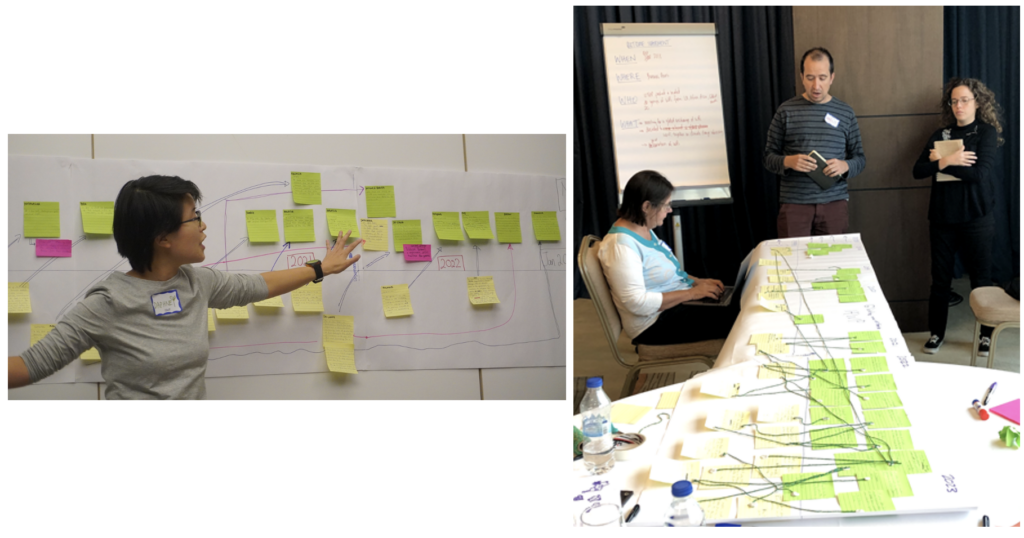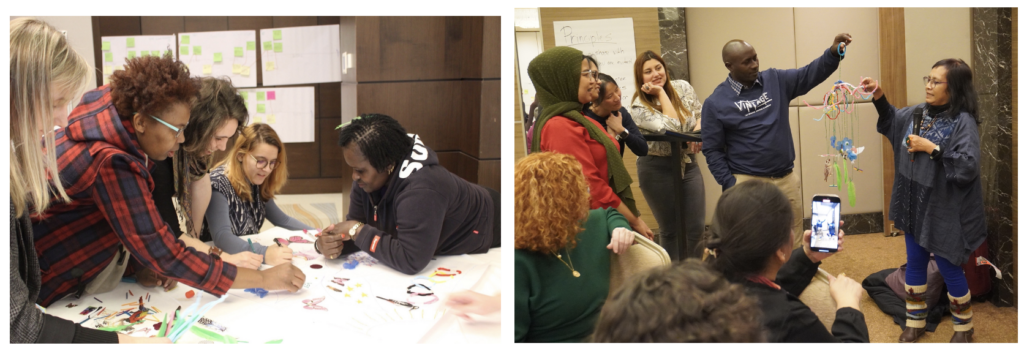Hello, I am Barbara Klugman, South African providing freelance strategy and evaluation support to funders, networks and organisations internationally. Story-telling was the core methodology used by the global network WIEGO with four global networks of informal economy workers’ organisations – International Domestic Workers Federation (IDWF), HomeNet International, StreetNet International and the International Alliance of Waste Pickers – to collectively work out how to build a workable monitoring and evaluation system that would support their collective learning and understanding of their work, and their ability to engage and report to their affiliates and funders. With Carmen Wilson-Grau and Rhonda Douglas, both of WIEGO, I co-facilitated a process where Networks each focused on one area of work – two on organisation building, as they are currently formalising themselves as international networks; two on campaigns – in the case of IDWF, for the domestication of ILO Convention on Domestic Work 189; in the case of StreetNet on efforts to win social protection for street vendors.
We used two steps. The first was Outcome Harvesting, where each person identified key moments of influence and their contribution towards these, told the story of how they had come about, with each of them adding in until they had woven their complex story of change. They put them on the wall chronologically, and the wall provided a visual to prompt sense-making of the story – What had we hoped would happen? What actually happened? Why? What was surprising, What was worrying? What does it mean in relation to what they’re trying to achieve and where should their emphasis be going forward? The process was experienced as very useful by participants for the insights it generated. Because they work globally and virtually, it brought together threads and details only some knew. That then reinforced the value of routinely capturing this kind of information so that it resides in the organisation and not only in the minds of individual staff or elected office bearers.

On right: Pablo Rey and Clara Ferraz of the International Alliance of Waste Pickers unpacking the process that led to the creation of the Alliance.
They then shared the full story with the other networks to build collective understanding of strategic routes taken, and deepen their solidarity.
Hot Tip:
For how to articulate outcomes, and ideas on how to run a participatory outcome harvest workshop see WIEGO Monitoring, Learning and Evaluation Toolkit.
For the second step, they interrogated what values and processes these experiences exemplified in relation to how they worked and learnt together, somewhat in the spirit of appreciative inquiry. This itself elicited stories of when and how they’d worked well, and when pressures on the ground had undercut their ability to take time for learning. They used this to imagine and create a story of themselves as “organisations whose staff and members are conscious of our thinking, notice our results, reflect on those results, and through this process, change our thinking and take action.”
Rad Resource:
This characterisation of a learning organisation is from Darling et al Emergent Learning.

Right: HomeNet International’s Edwin Bett and Suntaree Saeng-ging describing their mobile for fostering learning.
Having drawn or created a sculpture to capture this vision, they shared back with the other networks what being this organisation would mean, storytelling to generate a new sense of possibility.
In these ways, storytelling provided a vehicle to both understand how each network was achieving its objectives (and challenges on the way), and how they could use this accessible approach to build monitoring, evaluation and learning systems appropriate to their needs and their affiliates of informal economy workers’ organisations. The possibility of investing in organisational development, including MEL, was enabled by a joint grant, hosted by WIEGO, from the Ford Foundation, which did the unusual thing of giving them funds for this purpose rather than for external influence.
The American Evaluation Association is hosting Nonprofits and Foundations Topical Interest Group (NPFTIG) Week. The contributions all this week to AEA365 come from our NPFTIG members. Do you have questions, concerns, kudos, or content to extend this AEA365 contribution? Please add them in the comments section for this post on the AEA365 webpage so that we may enrich our community of practice. Would you like to submit an AEA365 Tip? Please send a note of interest to AEA365@eval.org. AEA365 is sponsored by the American Evaluation Association and provides a Tip-a-Day by and for evaluators. The views and opinions expressed on the AEA365 blog are solely those of the original authors and other contributors. These views and opinions do not necessarily represent those of the American Evaluation Association, and/or any/all contributors to this site.

Thank you so much for sharing this experience, Barbara! I have equally experienced the power of story-telling especially in Outcome Harvesting. Storytelling helps to capture the full complexity of the outcome and the context in which it occurred as well as the challenges faced. Story-telling can help capture both the intended as well as the unintended outcomes, especially in the details of the story and probing questions. There are some outcomes that may not even have been thought of as outcomes, but during the story-telling they emerge clearly and the contribution of the change agents can be discerned. Apart from providing the context and cultural underpinnings, story-telling may also help to identify some of the actors in the context, and this can go a long way through the force-field analysis to determine the degree of contribution (influence) of the change agent to the outcome. This comes in particularly handy, when you are using Podio or other applications that may require categorisation of the degree of influence, whether as a percentage or in a Likert scale.
This is an awesome approach as it offers learning for some and ownership of the outcomes of the process by all. Would like to know more. Thanks Barbara for sharing